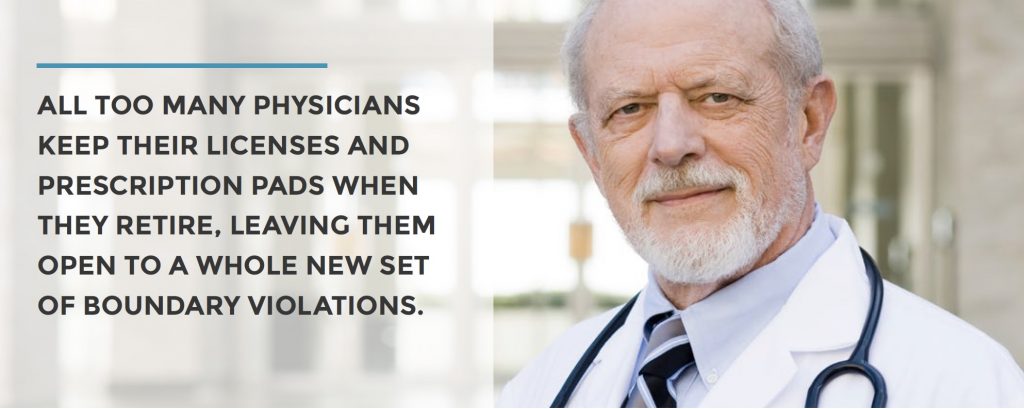The First Law of Boundary Violations…
The First Law of Boundary Violations…
and why physicians resist it at every stage of their careers.
Doctors in this country are arguably among the best educated in the world. And yet few know much of anything about their own potential to commit a career-ending boundary violation. As students in medical school, tomorrow’s physicians are far too focused on mastering basic science and clinical skills to think about the practical realities they will face after they get a license. And the pace doesn’t let up as they make their way through residencies and fellowships. And yet all those years of training, all the debt they’ve accumulated and the lives they’ve put on hold—all of it can be needlessly sacrificed by ignoring the first law of boundary violations: Everybody is a potential violator. Everybody.
The primary problem is that it is difficult for people who are so intelligent, well-intentioned, hard working and successful to fully grasp the implications of this simply-stated “law.” It’s one thing to understand it in the abstract, but quite another to recognize it in one’s daily life—until it is too late.
I have taught a good many proactive courses for large and small groups of doctors, trying to make them fully aware of their violation potential. Often sponsored by hospitals or large practices that have had physicians disciplined and hope to prevent further problems, these sessions are all too often limited to a couple of hours. That is simply too short a time to overcome the defenses people have built up, no matter where they are in their career—and every stage in a physician’s professional life brings new challenges.

The problem begins in medical school. In her 2012 commencement speech at the University of Texas Medical Branch in Galveston, Dr. Jennifer Arnold, summed up the situation this way:
Academic medicine and the media support arrogance, assertiveness, and even entitlement. As a medical student you had to overcome numerous intellectual, emotional, social and economic challenges to become a physician. The hidden curriculum of medical education promotes egoism, “I paid my dues, so now I am entitled to….” We are surrounded by personifications of physicians in the media that promote this as well. Television and film promote doctors who know it all (House, MD) or who are sexy, self confident, and always take charge in the operating room (Grey’s Anatomy). Patients come to you looking for answers, treatment, expertise, and even miracles. Yet, when we don’t know all the answers we are afraid to admit to our limitations.”
This fear of being less than perfect, and the compensating overconfidence it engenders tend to prevent young practitioners from looking at, let alone accepting their vulnerability to boundary violations, no matter how much it is explained to them.
More mature doctors face other obstacles. The changes that tend to trigger crises in midlife—the death of a parent, empty nesting, the reality of aging—do not spare physicians. And the forces unleashed make them more prone than ever to boundary violations as they, like so many of us, seek out ways to avoid or overcome the painful realities in their lives.

But by the time doctors arrive at this period of increased vulnerability, many have developed a feeling of invulnerability. After all, they have practiced for years with no problems, weathered all sorts of storms and have not only survived but even thrived in their profession. I cannot tell you how many times doctors have shown up at one of our classes, their long careers in shreds, expressing either complete disbelief and/or rage: “How could something like this happen to me?!”
Even as they approach retirement, doctors risk their reputations. According to the AMA, which devoted time to the subject of aging doctors at its 2015 Annual Meeting, about one in four U.S. physicians is older than 65, and that number more than quadrupled between 1975 and 2013.
As things stand now, it’s up to individual doctors to decide when to retire. (Unlike the commercial airline industry, which regularly screens pilots after they turn 40, the medical profession, notes the AMA, has “no national standard for screening physicians who have reached a certain age.”) And yet, as an AMA report makes clear, “Many older physicians also refrain from facing retirement altogether.” Speaking at a special session on the subject, Glen Gabbard, MD, a clinical professor of psychiatry at Baylor College of Medicine and an expert in physician health and professionalism, noted that, “For most of us, the practice isn’t a job: It’s more of a calling.” According to Gabbard, “One of the things that’s unique about physicians is that who we are—our identity—is so wrapped up in being a physician.” For many, the threat of losing not just their career but their identity is simply too great to face.
As a result, all too many physicians keep their licenses and prescription pads when they retire, leaving them open to a whole new set of boundary violations.
Despite the difficulty, we at PBI will continue to do all we can to alert physicians before it’s too late of the dangers that await them at each stage of their careers, because in the case of boundary violations, learning from experience is a terribly painful form of education.
View Other Posts
- Summer School: Reduce Stressors, Avoid Burnout
- Don’t Wait Until it is Too Late: How a Personalized Protection Plan© Decreases Violation Potential
- The What, Why, When, and How of Remedial Educational Interventions
- Revisiting Moral Courage as an Educational Objective
- If It Isn’t Documented, It Didn’t Happen
